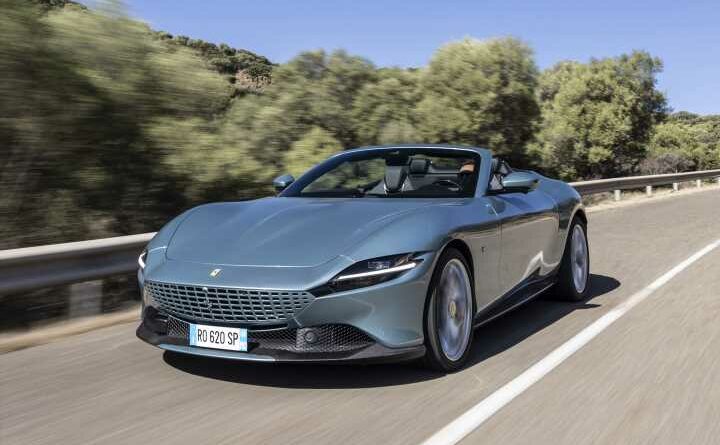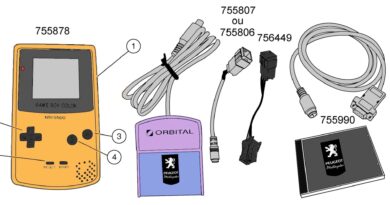2024 Ferrari Roma Spider | PH Review
The Roma rewrote the super-GT rulebook back in 2020 – can the new Spider do the same for four-seat convertibles?
By Cam Tait / Tuesday, 26 September 2023 / Loading comments
As Ferrari’s technical folk talk us through an exhaustive briefing on the new Roma Spider, it’s hard to not get completely lost in the gorgeous silhouette of the display car parked adjacent to the stage. The coupe is, to my eyes at least, the prettiest car to come out of Maranello in decades, though the new Berlinetta – Ferrari’s first front-engined, soft-top GT since the 365 GTS/4 – might have it beat. The Spider does away with the awkward, flat rear deck of its predecessor, the Portofino M, in favour of a sloping tail that mimics the roofline of the Roma coupe. Pretty Ferraris are back in fashion, folks. Long may it last.
But this is a technical briefing I really need to pay attention to because, as Ferrari puts it, this isn’t just a Roma with the roof cut off. Rather than adapting the coupe to accommodate a soft top, the manufacturer says it has created a “dedicated” chassis for the Spider, consisting of a new rear bulkhead and redesigned sills aimed at clawing back some of the lost structural rigidity, as well as mounting points for the new soft top mechanism.
It’s still predominantly a Roma underneath with traces of Portofino M, but Ferrari looks to have gone a step further than simply slapping on some strengthening rails and calling it a day. This, along with the folding roof, comes at an 84kg disadvantage, though it’s still 16 or so kilos lighter than the Portofino M. Progress.
Changes up front amount to a new oil filter and, er, that’s about it. So you’re still getting 620hp and 561lb ft from a 3.9-litre twin-turbocharged V8, only now it’s a little easier to hear without the roof getting in the way. That said, the clutches have been tweaked to make gear changes even more buttery smooth, though moving the Manettino into ‘race’ still delivers crisper shifts, as it did before. The optional Magneride dampers (set to be standard on all UK-bound cars) have also been retuned to account for the extra heft, though ultimately the Spider aims to get as close to the full Roma experience as possible. Albeit al fresco.
That’s no easy feat, mind, because the fixed-roof Roma pretty much rewrote the front-engined V8 Ferrari rulebook. For the first time, Maranello’s baby grand tourer had that razor-sharp edge that we all know and love from everything else to emerge from the factory gates, yet it could hunker down and play the mile-muncher when required, too. Chopping the roof off has the potential to undo all of that, leaving the Roma with just a pretty face, punchy powerplant and one of the world’s most recognisable badges stuck all over it.
Mere minutes into stepping into the Roma Spider, the Manettino is in the aforementioned ‘race’ mode and the sound of a flat-plane crank V8 is bouncing off the cliffs lining a sleepy Sardinian coastal road. Some have criticised the Roma’s soundtrack, muffled as it is by turbochargers and particulate filters, but with unobstructed access to a cylinder symphony and a 7,500rpm redline beckoning, goosebumps duly emerge. What a noise – one not undone by the satisfying click of the carbon paddle shifters and a noticeable step change as the next cog is instantly called into action. Short first-to-sixth ratios ensure you’re always on the powerband, with that LED strip on the steering wheel permanently illuminated.
In these conditions, the Roma Spider feels utterly electrifying. The smallest input of the wheel prompts an immediate response from the front axle. It’s not overly sensitive, and while it’s certainly light it never feels disconnected. The Roma Spider is an utter joy to navigate through non-stop switchbacks, always primed and ready to attack the next corner. Keep the revs up on exit and the back will step out, though Ferrari’s latest Side Slip Control 6 and a E-diff are there to step in if it senses you’re in over your head.
Great things have been written about the Roma’s chassis, so it’s remarkable how a car that should, on paper, be at a disadvantage feels as alive as the Spider does. The added weight just isn’t a factor in isolation, and nor do any unwanted shudders from the chassis creep in when you’re properly on it.
It’s a similar story when you dial it back to Comfort mode and lower the tempo. The roads in this part of southern Sardinia aren’t dissimilar to our own (backdrop aside), and the suppleness of the Roma Spider’s chassis allows it to soak up broken, pitted roads beautifully. If you happen to be in Sport or Race, a quick press of the Manettino activates the familiar ‘bumpy road’ mode, slackening off the dampers while everything else stays on high alert. Admittedly, there’s a degree of judder when traversing particularly nasty patches of tarmac, though it’s far from intrusive.
On that note, we should really talk about the bits that make it a Spider. The roof comprises five layers of fabric to dampen out as much wind and road noise as possible. It’s surprisingly hushed when in place, and when you want to lift the lid (which takes 13.5 seconds at speeds of up to 37mph) there’s a new wind deflector incorporated into the backs of the rear seats that pops up with the press of a button. Yes, I’ve checked, it doesn’t have the sort of force to eject rear occupants, but it does provide a degree of tranquillity when the roof’s off and the windows are raised. Buffeting isn’t a problem, either, even at Italian autostrade speeds – and perhaps a bit beyond.
While we’re in the cabin, the steering wheel has been given a refresh and now incorporates grooves to help guide you to the right touch controls without taking your eyes off the road, though it could really do with haptic feedback to go along with the audible ‘click’ that confirms button presses. And once you set off, you need to wake the touch controls by pressing the confirm button on the right arm of the wheel. This is presumably so you don’t accidentally hit the driver assistance buttons while sliding around hairpins, which is actually a pretty neat feature – though I was frantically hammering the wheel trying to shut up the constant bonging of the ADAS.
But these are just minor niggles in what is otherwise a fantastic super GT. No, it’s not ultimately as pillowy as a Continental GTC, and good luck trying to fit anything other than children or suitcases into the not-an-ejector seat in the rear. But it’s the Roma Spider’s ability to switch between continental cruiser and laser-focused supercar at the flick of a dial that makes it feel every bit the versatile GT the coupe was originally lauded as. So then, what’ll it be? Roof or no roof?
SPECIFICATION | FERRARI ROMA SPIDER
Engine: 3,855cc V8, twin-turbo
Transmission: eight-speed twin-clutch automatic, rear-wheel drive
Power (hp): 620@5,750-7,500rpm
Torque (lb ft): 561@3,000-5,750rpm
0-62mph: 3.4sec
Top speed: 199mph
Weight: 1,556kg (dry)
MPG: 24.7
CO2: 258g/km
Price: £210,313 (starting; price as tested £287,753, including Magneride dual suspension for £3,390, glossy carbon fibre steering wheel with LEDs at £3,082, ADAS full package at £5,546, glossy carbon fibre rear diffuser at £7,190, carbon fibre front splitter at £3,595, Ferrari historical colour (Celeste Metallic) at £7,601 and sports exhaust pipes at £514).
- 2021 Ferrari Roma | UK Review
- 2023 Ferrari 296 GTS | PH Review
Source: Read Full Article



